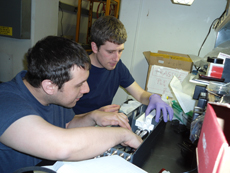Muon g-2 off to a running start
 |
|
Brendan Kiburg (left) and Peter Winter (right) assemble a detector prototype for the Muon g-2 experiment. Tests occurred in the Fermilab Test Beam Facility. Photo: Volodya Tishchenko |
Muon g-2 scientists are on the hunt for the perfect detector that will satisfy their experimental needs and prepare the project for an upcoming NSF grant review. Muon g-2 collaboration members from across the country assembled at Fermilab to test-drive the different detector options with the electron beam in the Fermilab Test Beam Facility the week of April 11. FTBF manager Aria Soha and her team were on deck to lend a hand.
"Aria and the FTBF group provide an incredible facility for users who need to understand and assess their devices before incorporating them into an experiment," said Muon g-2 co-spokesperson Dave Hertzog.
The Muon g-2 experiment examines the precession, or wobble, of muons that are subjected to a magnetic field. The main goal is to test the Standard Model's predictions of this value by measuring the precession rate experimentally. Researchers will accomplish this with 24 detectors installed inside a muon storage ring.
"The detectors have to have a very fast response rate and be compact because space in the ring is limited," said Hertzog. "They also have to have a high resolution and be non-magnetic as to not disturb the magnetic field in the storage ring."
The Muon g-2 experimenters tested and tweaked three different types of detectors looking for ways to optimize their performance.
"It's about finding the right recipe," said Hertzog. "We vary the small things and see if we can improve the detector resolution."
Currently, the experiments are choosing between two types of calorimeters, which generate light when a particle is detected, and two types of readouts, which translate this light into an electrical signal.
"The readouts will be either large-area silicon photomultipliers (SiPMs), which can be used in the magnetic field of the storage ring, or conventional photomultipliers, which must be located well away from the ring," Hertzog said.
The experiment's plan A—largely affirmed in tests—uses SiPM arrays and lead fluoride crystals for the calorimeter. Muon g-2 scientists will spend the next several months analyzing the data, preparing a final decision and, eventually, a funding proposal.
"It's been a long week with little sleep," Hertzog said. "But we're excited about the progress."
—Sarah Charley
|